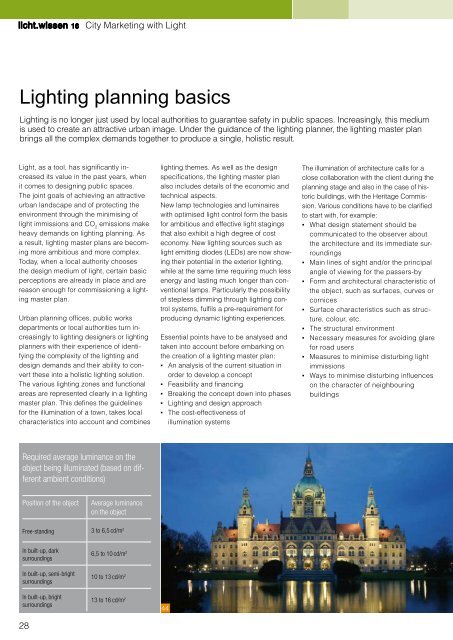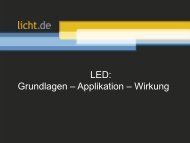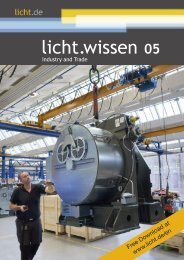licht.wissen No. 16 “City Marketing with Light“
City marketing with light offers the unique opportunity to create effects that are just not possible during the daytime and to enhance the attractiveness of public areas. Booklet No. 16 informs about city marketing and for example special informations about the LED technology.
City marketing with light offers the unique opportunity to create effects that are just not possible during the daytime and to enhance the attractiveness of public areas. Booklet No. 16 informs about city marketing and for example special informations about the LED technology.
You also want an ePaper? Increase the reach of your titles
YUMPU automatically turns print PDFs into web optimized ePapers that Google loves.
<strong>licht</strong>.<strong>wissen</strong> <strong>16</strong> City <strong>Marketing</strong> <strong>with</strong> Light<br />
Lighting planning basics<br />
Lighting is no longer just used by local authorities to guarantee safety in public spaces. Increasingly, this medium<br />
is used to create an attractive urban image. Under the guidance of the lighting planner, the lighting master plan<br />
brings all the complex demands together to produce a single, holistic result.<br />
Light, as a tool, has significantly increased<br />
its value in the past years, when<br />
it comes to designing public spaces.<br />
The joint goals of achieving an attractive<br />
urban landscape and of protecting the<br />
environment through the minimising of<br />
light immissions and CO 2<br />
emissions make<br />
heavy demands on lighting planning. As<br />
a result, lighting master plans are becoming<br />
more ambitious and more complex.<br />
Today, when a local authority chooses<br />
the design medium of light, certain basic<br />
perceptions are already in place and are<br />
reason enough for commissioning a lighting<br />
master plan.<br />
Urban planning offices, public works<br />
departments or local authorities turn increasingly<br />
to lighting designers or lighting<br />
planners <strong>with</strong> their experience of identifying<br />
the complexity of the lighting and<br />
design demands and their ability to convert<br />
these into a holistic lighting solution.<br />
The various lighting zones and functional<br />
areas are represented clearly in a lighting<br />
master plan. This defines the guidelines<br />
for the illumination of a town, takes local<br />
characteristics into account and combines<br />
lighting themes. As well as the design<br />
specifications, the lighting master plan<br />
also includes details of the economic and<br />
technical aspects.<br />
New lamp technologies and luminaires<br />
<strong>with</strong> optimised light control form the basis<br />
for ambitious and effective light stagings<br />
that also exhibit a high degree of cost<br />
economy. New lighting sources such as<br />
light emitting diodes (LEDs) are now showing<br />
their potential in the exterior lighting,<br />
while at the same time requiring much less<br />
energy and lasting much longer than conventional<br />
lamps. Particularly the possibility<br />
of stepless dimming through lighting control<br />
systems, fulfils a pre-requirement for<br />
producing dynamic lighting experiences.<br />
Essential points have to be analysed and<br />
taken into account before embarking on<br />
the creation of a lighting master plan:<br />
▪ An analysis of the current situation in<br />
order to develop a concept<br />
▪ Feasibility and financing<br />
▪ Breaking the concept down into phases<br />
▪ Lighting and design approach<br />
▪ The cost-effectiveness of<br />
illumination systems<br />
The illumination of architecture calls for a<br />
close collaboration <strong>with</strong> the client during the<br />
planning stage and also in the case of historic<br />
buildings, <strong>with</strong> the Heritage Commission.<br />
Various conditions have to be clarified<br />
to start <strong>with</strong>, for example:<br />
▪ What design statement should be<br />
communicated to the observer about<br />
the architecture and its immediate surroundings<br />
▪ Main lines of sight and/or the principal<br />
angle of viewing for the passers-by<br />
▪ Form and architectural characteristic of<br />
the object, such as surfaces, curves or<br />
cornices<br />
▪ Surface characteristics such as structure,<br />
colour, etc.<br />
▪ The structural environment<br />
▪ Necessary measures for avoiding glare<br />
for road users<br />
▪ Measures to minimise disturbing light<br />
immissions<br />
▪ Ways to minimise disturbing influences<br />
on the character of neighbouring<br />
buildings<br />
Required average luminance on the<br />
object being illuminated (based on different<br />
ambient conditions)<br />
Position of the object<br />
Average luminance<br />
on the object<br />
Free-standing 3 to 6,5 cd/m 2<br />
In built-up, dark<br />
surroundings<br />
In built-up, semi-bright<br />
surroundings<br />
In built-up, bright<br />
surroundings<br />
28<br />
6,5 to 10 cd/m 2<br />
10 to 13 cd/m 2<br />
13 to <strong>16</strong> cd/m 2<br />
44

















